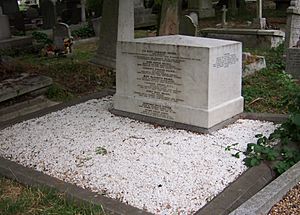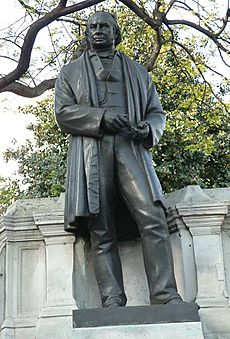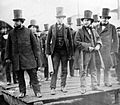Isambard Kingdom Brunel facts for kids
Quick facts for kids
Isambard Kingdom Brunel
|
|
|---|---|
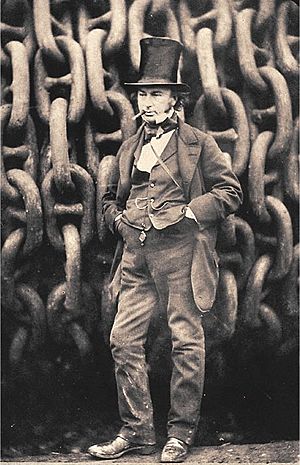
|
|
| Born | 9 April 1806 Portsmouth, England
|
| Died | 15 September 1859 (aged 53) Westminster, London, England
|
| Nationality | British |
| Education |
|
| Occupation | Engineer |
| Spouse(s) | Mary Elizabeth Horsley |
| Children |
|
| Parent(s) |
|
| Engineering career | |
| Discipline | |
| Institutions | Institution of Civil Engineers |
| Projects | |
| Significant design | Royal Albert Bridge |
| Signature | |
 |
|
Isambard Kingdom Brunel (born April 9, 1806, died September 15, 1859) was a brilliant English engineer. He worked on both mechanical and civil engineering projects. Many people consider him one of the most clever and productive engineers ever. He was a giant of engineering in the 1800s. Brunel truly changed England with his amazing designs and buildings.
He built many important things. These include dockyards, the famous Great Western Railway, and a series of steamships. One of his ships was the first propeller-driven ship to cross the Atlantic Ocean. He also designed many important bridges and tunnels. His ideas completely changed how people traveled and how engineering was done.
Even if his projects didn't always work out perfectly, they often had clever new ideas. Brunel achieved many first-ever engineering feats during his career. For example, he helped build the first tunnel under a river that ships could sail on. He also developed the SS Great Britain, which was the first iron ship to be driven by a propeller and sail on the ocean. When it was built in 1843, it was the largest ship ever made!
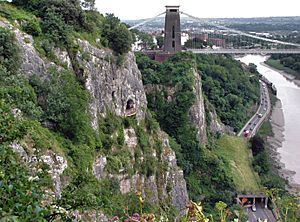
Brunel set a high standard for building railways. He carefully surveyed the land to make sure the tracks were as flat and straight as possible. This meant using expensive building methods. It also required new bridges, viaducts (long bridges), and the two-mile-long Box Tunnel. One interesting feature of his railway was its wide "broad gauge" of 7 ft 1⁄4 in (2,140 mm). This was different from the "standard gauge" of 4 ft 8 1⁄2 in (1,435 mm) used later.
Brunel surprised everyone by suggesting that the Great Western Railway should connect to North America. He planned to do this by building large, iron ships powered by steam. He designed and built three ships that changed naval engineering forever: the SS Great Western (1838), the SS Great Britain (1843), and the SS Great Eastern (1859).
In 2002, people in a BBC public poll voted Brunel second in a list of the "100 Greatest Britons". In 2006, which was 200 years after he was born, many events celebrated his life and work. This celebration was called Brunel 200.
Brunel's Life
In 1830, Brunel was chosen to be a Fellow of the Royal Society. This is a very respected group of scientists.
On July 5, 1836, Brunel married Mary Elizabeth Horsley. She came from a talented family of musicians and artists. Her father, William Horsley, was a composer and organist. They made their home in London, on Duke Street in Westminster.
In 1843, something strange happened. Brunel was doing a magic trick for his children. He accidentally breathed in a small coin, which got stuck in his windpipe. Doctors tried to remove it with special tools, but it didn't work. Brunel even invented a machine to shake it loose! Finally, his father suggested strapping him to a board and turning him upside-down. The coin then came out. He recovered in Teignmouth. He liked the area so much that he bought land there. He hired someone to design Brunel Manor and its gardens as his country home. Sadly, he died before the house and gardens were finished.
Brunel was a heavy smoker. He suffered a stroke in September 1859. This happened just before his ship, the Great Eastern, made its first trip to New York. He passed away ten days later at 53 years old. He was buried, like his father, in Kensal Green Cemetery in London. His grave is quite simple and easy to miss.
He left behind his wife Mary and three children. They were Isambard Brunel Junior (1837–1902), Henry Marc Brunel (1842–1903), and Florence Mary Brunel (1847–1876). Henry Marc followed in his father's footsteps and became a successful civil engineer.
Brunel's Lasting Impact
Brunel was a famous engineer during his time. He is still highly respected today. Many statues and monuments honor him. You can find statues in London at Temple, Brunel University, and Paddington station. There are also statues in Bristol, Plymouth, Swindon, Milford Haven, and Saltash. Sadly, a statue in Neyland, Wales, was stolen in 2010. The top part of the Great Eastern ship is now used as a flagpole at Anfield, the home of Liverpool Football Club.
Many places today are named after Brunel. These include Brunel University in London and shopping centers in Swindon and Bletchley, Milton Keynes. There are also streets in Exeter named Isambard Terrace, Kingdom Mews, and Brunel Close. In his hometown of Portsmouth, a road, a car park, a school, and a large pub are named after him. The University of Plymouth also has an engineering lab building named in his honor.
In the 2002 BBC poll for the 100 Greatest Britons, Brunel came in second place. He was only behind Winston Churchill. Brunel's life and work have been shown in many books, movies, and TV shows. The 2003 book and BBC TV series Seven Wonders of the Industrial World included a play about building the Great Eastern.
Many of Brunel's bridges are still used today. His first engineering project, the Thames Tunnel, is now part of the London Overground train network. The Brunel Engine House in Rotherhithe once held the steam engines that pumped water from the tunnel. Now, it is the Brunel Museum, dedicated to the work of both Isambard Kingdom Brunel and his son, Henry Marc Brunel. Many of Brunel's original papers and designs are kept at the Brunel Institute in Bristol, next to the SS Great Britain. Researchers and visitors can see them for free.
Brunel is also known for helping the town of Swindon grow very quickly in the 1800s. He chose Swindon for the Great Western Railway's locomotive sheds. This meant many workers needed homes. So, Brunel built hospitals, churches, and houses in what is now called the 'Railway Village'. Some people even believe that Brunel's idea of providing a Mechanics Institute (for recreation) and hospitals for his workers helped inspire the creation of the National Health Service in the UK.
Several trains have been named after Isambard Kingdom Brunel. These include the GWR Castle Class steam locomotive no. 5069. Also, the BR Western Region diesel locomotive no. D1662 (later 47484) was named after him. Today, Great Western Railway has named both its old InterCity 125 power car 43003 and new InterCity Electric Train 800004 as Isambard Kingdom Brunel.
In 2006, the Royal Mint made two special £2 coins. These coins celebrated the 200th anniversary of Brunel's birth and his achievements. One coin shows Brunel with a part of the Royal Albert Bridge. The other shows the roof of Paddington Station. The Post Office also released a set of special stamps.
For the 100th anniversary of the Royal Albert Bridge, the words "I.K. BRUNEL ENGINEER 1859" were carved into both ends of the bridge. This was to remember his lasting impact. The words had been covered by paint, but Network Rail restored them in 2006.
Brunel was the subject of Great, a 1975 animated film directed by Bob Godfrey. It won an Academy Award for Animated Short Film in 1976.
The song "The Underfall Yard" by the band Big Big Train is a tribute to great English engineers, including Brunel. He worked on the Underfall Yard itself in the 1830s.
At the 2012 Summer Olympics opening ceremony, actor Kenneth Branagh played Brunel. This was part of a show about the Industrial Revolution.
The steampunk musical group The Men That Will Not Be Blamed for Nothing has a song called Brunel. It talks about Brunel's achievements as an engineer.
The 2013 album The Last Ship by Sting includes the song "Ballad of the Great Eastern".
Images for kids
-
The Thames Tunnel in 2005
-
The Clifton Suspension Bridge spans Avon Gorge, linking Clifton in Bristol to Leigh Woods in North Somerset
-
The Royal Albert Bridge spanning the river Tamar at Saltash
-
Paddington station, still a mainline station, was the London terminus of the Great Western Railway
-
A reconstruction of Brunel's atmospheric railway, using a segment of the original piping at Didcot Railway Centre
-
A section of the actual pipe in the Swindon Steam Railway Museum
-
Maiden voyage of the Great Western in April 1838
-
Launch of the Great Britain in 1843
-
Great Eastern shortly before launch in 1858
-
Brunel at the launch of the Great Eastern with John Scott Russell and Lord Derby
See also
 In Spanish: Isambard Kingdom Brunel para niños
In Spanish: Isambard Kingdom Brunel para niños


